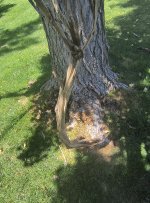doc spring _work
Chumono
Been thinking about doing a tanuki (Phoenix graft) for a long time debating different trees and styles.
Yesterday I was at the nursery getting another bald cypress to air layer when I saw a weeping Norway spruce.
I decided I would finally grab some of the sage deadwood I've collected, sat there grinding a channel into the wood and coated it in pine tar (as a seal and coloring agent... I know it's not traditional)
Upsized the pot using mostly perlite and a top layer of peat, I intend to let the tree grow quite a bit more before doing anything.
Dew for scale, thoughts appreciated.
Yesterday I was at the nursery getting another bald cypress to air layer when I saw a weeping Norway spruce.
I decided I would finally grab some of the sage deadwood I've collected, sat there grinding a channel into the wood and coated it in pine tar (as a seal and coloring agent... I know it's not traditional)
Upsized the pot using mostly perlite and a top layer of peat, I intend to let the tree grow quite a bit more before doing anything.
Dew for scale, thoughts appreciated.









